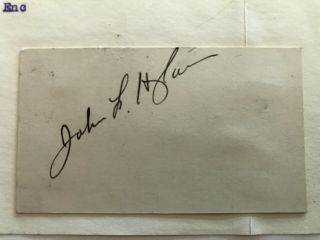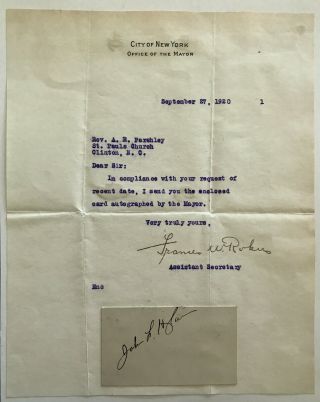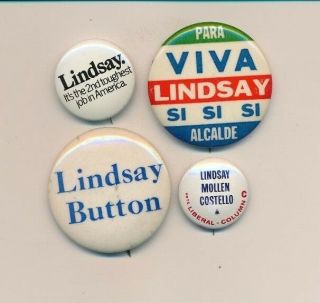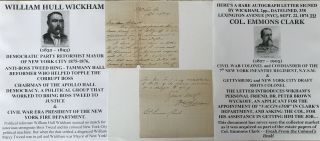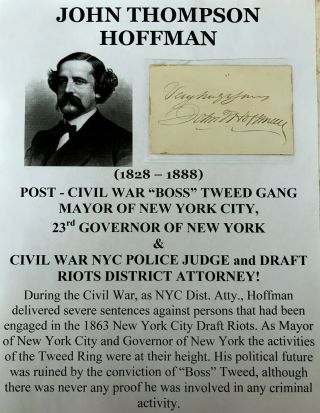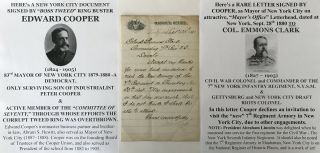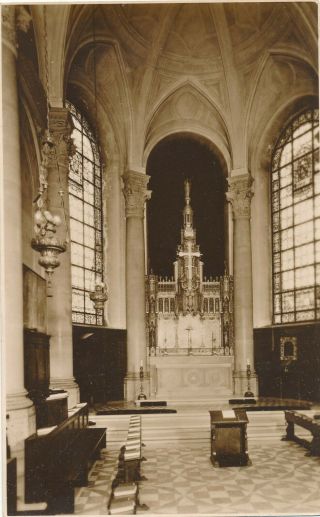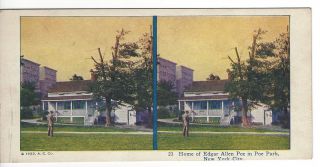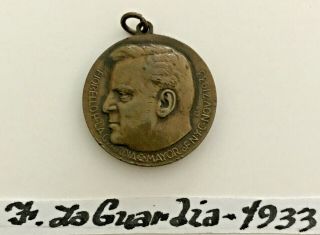96th MAYOR YORK CITY 1918 - 1925 JOHN F. HYLAN AUTOGRAPH SIGNED W/LETTER 1920
Item History & Price
JOHN F. HYLAN(1868 - 1936)96th MAYOR OF NEW YORK CITY1918-1925, HERE'SAN AUTOGRAPH SIGNATURE CARD, MOUNTED TO A LETTER SIGNED BY HYLAND’S SECRETARY, DATED and SIGNED:“John F. Hyland”The document is in VFCondition.AFINE ADDITION TO YOUR NEW YORK CITY POLITICAL HISTORY AUTOGRAPH, MANUSCRIPT& EPHEMERA COLLECTION! BIOGRAPHICAL SKETCH OF THE HONORABLEJOHN F. HYLANJohn Francis Hylan (April 20, 1868 –January 12, 1936) was the 96th Mayor of New York City(the seventh since the ...consolidation of the five boroughs), from 1918 to 1925.From rural beginnings in the Catskills, Hylan eventually obtained work in Brooklynas a laborer on the elevated railroad. During his nine years with the company, he worked his way to engineer, and also studied to earn his high school diplomathen his law degree. He practiced law for nine years and also participated inlocal Democratic politics. In 1917 with the consent of Tammanyand William Randolph Hearst, he was put forward as a Brooklyn Democratic candidate for Mayor and won thefirst of two terms. He was re-elected with a wide plurality, which swept manyBrooklyn Democrats into office. His chief focus in office was to keep subwayfares from rising. By the end of his second term, however, a report by acommittee appointed by Governor Al Smithseverely criticized his administration's handling of the subway system. Tammanyran Jimmy Walkeragainst him for the Democratic nomination and Hylan lost. Walker appointed himto the Children's Court where he sat for many years. After his term as mayor, Hylan spent much time attacking the "interests, " arguing thatindustrial concentration gave great power to individuals to influence politicsand impoverish the working poor.Early lifeHylan was born in 1868 in Hunter, New York, a town in upstate Greene County.He was the third child, and had two older sisters and two younger brothers. Hylan'sfather had emigrated from County ofCavan, Ulster, Ireland at the age of seven.He served as a corporal in the 120th New York Infantry, called the "UlsterRegiment, " during the Civil War.Hylan's mother, who came from the Jones family upstate, had a Welsh father and a maternal grandfather, Jacob Gadron, who fought in the American Revolutionamong Lafayette'sforces. He fondly remembered her throughout his life and wrote that the wordsshe spoke on leaving the family ("Be honest, be truthful, be upright, anddo by others as you would have them do unto you") were "indeliblyimprinted on" his memory. Although his mother was Methodist, Hylan wasraised a Catholic. His only surviving family, his sister Mary, died after beingstruck by an automobile on July 10, 1911.Hylan's family owned a 60-acre farm in the then-undeveloped mountains andstruggled to make the semi-annual interest on its $1, 500 mortgage. As theoldest boy, Hylan was required to work long hours on the farm, which was notequipped with much more than hand tools. Farm work came first, the schooldistrict was impoverished, and only one family could afford the requiredgrammar or history book, which Hylan occasionally borrowed. School lasted fourto five hours a day for five months a year. In his teenage years, Hylan madeextra money to help pay the mortgage interest by working each spring for the Catskill railroad, digging earth and tamping it beneath the tracks to stabilize them after theeffects of winter weather.Early careerBy the winter of 1887, when he was 19, Hylan felt he could make more moneyfor his parents by working downstate. So, with $3.50 and a few sets of clothes, he set off to New York, buying a $2 train ticket and then proceeding across theBrooklyn Bridge.On his first day he saw construction on an elevated railroad. Although he hadnever seen such a thing before, he climbed onto the structure and asked theforeman for a job, saying that he had worked on the Catskill railroad. He wastold to report the next day, where his job was to lay rails. Seeking apromotion, he would apply at the office of the manager of the Brooklyn Union ElevatedRailroad each day until he was finally granted an interviewand promoted to fireman.He made $1.50 a day for this heavy labor. He reported to the East New Yorkstation on March 11, 1888, the day of the Great Blizzard. After two years as stoker, then asengine hostler, Hylan passed the required test and was given a job as anengineer, in "one of the happiest moments of [his] life." Making$3.50 a day, he said, "finally landed [him] on the right side of theengine cab." But it required long hours: 13-hour runs on weekdays, 12hours on Saturdays, and 11 on Sundays.When Hylan felt himself economically secure, even before he becameengineer, he went back to Hunter and married his childhood sweetheart MarianO'Hara, and they moved to Bushwick, a section of Brooklyn where they would spend most of the rest of their lives.During his years as a motorman, he regularly paid the $75 semiannual interestpayment for his family's farm and paid the principal off before he left thatjob. Hylan wrote that he had no inclination to seek any other position once hewas settled and making $100 a month. Hylan considered law because his youngerbrother, who had been studying law and on whom his parents had pinned hopes andfamily pride, had died. His wife encouraged him, but because of his limited education, he had to study at the Long Island Business College to prepare himself for his Regents exambefore he could begin to study law. He got into law school with the help of hiswife, as well as that of a teacher who gave up his lunch hour to help and forwhom Hylan later found a position in the Department of Water Supply, Gas andElectricity when he became mayor.After he passed his Regents exam, he enrolled in New York Law Schoolwhere Woodrow Wilson, who was teaching Constitutional Law there at the time, was among hisprofessors. After graduating in October 1897, Hylan clerked for LongIsland City attorney James T. Olwell. He prepared himself in twoand a half years. The earliest bar exam he could take was in Syracuse, butimmediately before he was set to take the exam, he was involved in a nearaccident with the railroad's supervisor. Hylan said that it was the supervisor'sfault, but nonetheless, he was fired. Even so, the privileges of his membershipin the Brotherhoodof Locomotive Engineers enabled him to travel to Syracuse atno charge, and he passed the bar exam.Law and politicsLaw careerHylan learned that law practices required startup cash, so he mortgagedthe farm again to raise $500. With that sum, he set up an office on the cornerof Gates Avenue and Broadwayin Bushwick. He made $24 his first month, but gradually built up a good civillitigation practice. He soon formed a partnership with Harry C. Underhill, anattorney who had written a treatise on evidence and would go on to write onother practice topics. Underhill did the office work, while Hylan was the triallawyer.The firm occasionally received positive local publicity, such as the time whenthey obtained a ruling that the Brooklyn Heights Railroad Companyhad to offer free transfers at all junctions. Hylan litigated small civil casesand family law matters, but he had little work in the police courts and"never cared for that branch of the law."After eight years in the courts of Brooklyn, he was respected enough tobegin getting appointments within the power of local judges.Hylan had higher ambitions, so he began making the kind of connections expectedof someone considering a run for higher office. One connection he made, albeitby accident, was John H. McCooey, the future Brooklyn Democratic Party boss; they met when McCooey was a postalclerk and Hylan was sending money orders to his parents for interest paymentson the family farm's mortgage. Hylan would remain grateful for the kindnessMcCooey showed him, and they remained friends thereafter. Other contacts weremade by constant attendance at local organizations, political and otherwise. Inaddition to his union membership, which he kept up even when he was mayor, hewas a member of the Foresters of America, the Broadway Board of Trade, theTwenty-eighth Ward Taxpayer Association, and he began working his way up thelocal Democratic club. Politics and judgeshipsHylan emerged from obscurity in Brooklyn Democratic politics during thecitywide elections of 1903, a campaign during which several internal Democraticpower struggles worked themselves out. In Manhattan Charles Francis Murphyhad recently replaced RichardCroker as head of the Tammany machine. Murphy, who hadbecome independently wealthy from a trucking company which leased docks fromthe city and rented them to shipping companies, fixed his goal as Tammany chiefto extend Tammany influence to all the boroughs and then beyond. He decided todislodge Fusionist mayor Seth Low by running George B. McClellan Jr., son of the Civil War generalwho had run against Lincolnin 1864.The move was unpopular in Brooklyn, whose leaders believed that McClellanwould hurt down-ticket Brooklyn candidates; they concluded that runningMcClellan likely would cost them the district attorney and sheriff's offices, not to mention borough and judicial races. Some observers believed that it wasMurphy's intention, despite the risk of lost votes in Brooklyn, as long as hecould cut off the Kings County party's independent base of patronage. Murphy's highhandedness rankled others aswell. At the City Committee meeting on September 18, party leaders from Queens, the Bronx and Richmond joined Brooklyn in expressing their concern. Independent Manhattan Democrats also objectedto Murphy's action, including the Greater New York Democracy, which decided forthe Fusion ticket, and formerTammany police chief Bill Devery, who decided to run for Mayor himself. Even several Tammany chiefs questioned thewisdom of the McClellan choice. Brooklyn partyleader Hugh McLaughlindecided to test Murphy's hold over the outer boroughs and gave an interviewpromising to oppose Murphy's nominee at the city convention.At the Democratic City Committee meeting on September 24, Murphy defiedBrooklyn leaders to take the fight over McClellan to the Convention the nextweek, knowing that Tammany controlled a majority of the delegates. With a viewto sowing confusion among the Fusionists, Murphy without consultation outsideof Tammany proposed adding two Fusion candidates to the ticket—Edward M. Groutfor Controller and Charles V. Fornes for President of the Board of Aldermen.The proposed nomination of two Fusion candidates by Tammany so disturbed thenon-Tammany Democrats that, after much behind-the-scenes scheming, McLaughlinannounced a complex plan the day before the convention to either dislodgeMcClellan from the ticket and Murphy from Tammany in the process or provide ananti-Tammany Democratic ticket that would run against Tammany's ticket. The convention took place on October 1, 1903 at Carnegie Hall. At thebeginning it looked as if the Kings County delegation could engineer a stampedeagainst the Tammany ticket. Brooklyn Assistant District Attorney Martin W. Littletonled the charge, looking directly at Murphy in front of him and delivering ablistering speech scoring Tammany "treachery" for selectingDemocratic "traitor" Grout. Robert H. Elder followed him, placing innomination Julian D. Fairchild in Grout's place and reminded the conventionthat Grout had been a Republican and left the Brooklyn Democrats because oftheir association with Tammany. Littleton rose again to remind the delegatesthat Grout once called Tammany a "stench in his nostrils." And the"excitement reached a climax" when one Tammany leader broke withMurphy against Grout causing "wild applause." Murphy and the Tammany leaders sat through theabuse, smiling, and in the end the Brooklyn Democrats were routed by the nearunanimous Tammany vote. While the Kings County delegation under the leadershipof state senator Patrick H. McCarrenmade show of unity by moving the unanimous nomination of McClellan when itsnominee was defeated, a similar motion for Grout and Fornes, however, was"howled down." The next day at the Brooklyn Democratic headquarters in the auction roomon Willoughby Street, all talk of McLaughlin's plan for an opposition ticket toTammany's had ceased. If McClellan won the mayoralty, all Brooklyn patronagewould go through him and Tammany. While Brooklyn maintained its objection toGrout and Fornes, that did little good for the Brooklyn party unless McClellanlost, but McCarren and the rest at the Convention eventually endorsedMcClellan. As one Democrat put it: "Tammany's coming to Brooklyn sure andthe Old Man [McLaughlin] will take his medicine." For McLaughlin whether he would remain incharge of the Brooklyn Democrats now depended on his former subordinateMcCarren. McCarren, however, used the occasion to take over the Brooklynorganization, and in the turmoil Hylan made his first move for partyadvancement. Mayor of New York CityHylan defeated the reformer John Purroy Mitchelin the four-sided 1917 mayoral election, restoring the power of Tammany at CityHall. Hylan was the first Democratic candidate to obtain a significant portionof the African Americanvoter base. He easily wonre-election in 1921 but was defeated for re-nomination in 1925 by State SenatorJames J."Jimmy" Walker. Walker later appointed Hylan to themunicipal judiciary. As mayor, Hylan railed against "the interests"and put in motion the building of the Independent Subway System, which would later become part of the New York City Subway.On December 30, 1925, Hylan resigned from office one day before the end of histerm in order to assure his eligibility for a $4, 205 annual pension from thecity. The 14-mile (23 km) HylanBoulevard in StatenIsland was renamed for him in 1923 over the protests of hispolitical opponents.Hylan developed a reputation for not being exceptionally intelligent orwell-spoken. According to RobertMoses, Hylan went through most of a mayoral campaign usingjust one stump speech: a call to keep the five-cent subway farein place. He asked for Moses' help in preparing another, and Moses obliged. Thefirst time Hylan tried to deliver the new speech, he reached the climax—a Revolutionary War-inspired"I call for the spirit of 1776"—but rather than closing out on a highnote, Hylan missed the context and read out the number's digits, saying, "I call for the spirit of one-seven-seven-six."In another story recounted about Hylan's supposed lack of intelligence andarticulateness, his successor JimmyWalker appointed Hylan as judge of the Queens Children'sCourt. When journalist AlvaJohnston asked Walker why he would appoint a rival to ajudgeship, Walker quipped, "The children now can be tried by theirpeer." Famous speechHylan's most famous statement against "the interests" was thefollowing speech, made in 1922, while he was the sitting Mayor of New YorkCity: The real menace of our Republic is the invisible government, which like agiant octopus sprawls its slimy legs over our cities, states and nation. Todepart from mere generalizations, let me say that at the head of this octopusare the Rockefeller–StandardOil interests and a small group of powerful banking housesgenerally referred to as the international bankers. The little coterie ofpowerful international bankers virtually run the United States government fortheir own selfish purposes. They practically control both parties, write political platforms, makecatspaws of party leaders, use the leading men of private organizations, andresort to every device to place in nomination for high public office only suchcandidates as will be amenable to the dictates of corrupt big business. These international bankers and Rockefeller–Standard Oil interests controlthe majority of the newspapers and magazines in this country. They use thecolumns of these papers to club into submission or drive out of office publicofficials who refuse to do the bidding of the powerful corrupt cliques whichcompose the invisible government. It operates under cover of a self-createdscreen [and] seizes our executive officers, legislative bodies, schools, courts, newspapers and every agency created for the public protection.DeathHylan died of a heart attack at the age of 67 on January 12, 1936, at hishome in Forest Hills, Queens.In popular cultureIn the first issue of The NewYorker (February 21, 1925), a humor piece on the history ofNew York refers to John F. Hylan as "Jonef Hylan": The next great figure in the early legends of New York is that of JonefHylan. Hylan, in all probability, was not a real person; but it is impossibleto understand New York without giving careful study to the Hylan myth. In manyrespects, it resembles the Sun Myth of other great civilizations; for his headwas as a head of flame, and he rose early each morning from beyond the EastRiver, bringing light into all the dark places and heat into the sessions ofthe Board of Estimate.The populace called their Sun God "Red Mike"; but in the frenzy oftheir devotions, they simply yelled "Ra! Ra!"He is then characterized as a "Champion of the People versus theInterests", which are "not people". Satan, it says, was behind the Interests, but William Randolph Hearstwas behind Hylan, "and that evened things up". In the April issue of The New Yorker the same year, a cartoon byAlfred Frueh shows firefighters carrying people from a burning building wearingplacards with notices such as "This lucky man is being rescued by MayorHylan's firemen." I am a proud member of theUniversal Autograph Collectors Club (UACC), The Ephemera Society of America, the Manuscript Society and the American Political Items Collectors (APIC)(member name: John Lissandrello). I subscribe to each organizations' code of ethicsand authenticity is guaranteed. ~Providing quality service and historicalmemorabilia online for over twenty years.~
WE ONLY SELL GENUINE ITEMS, i.e., NO REPRODUCTIONS, FAKES OR COPIES!
WE ONLY SELL GENUINE ITEMS, i.e., NO REPRODUCTIONS, FAKES OR COPIES!




